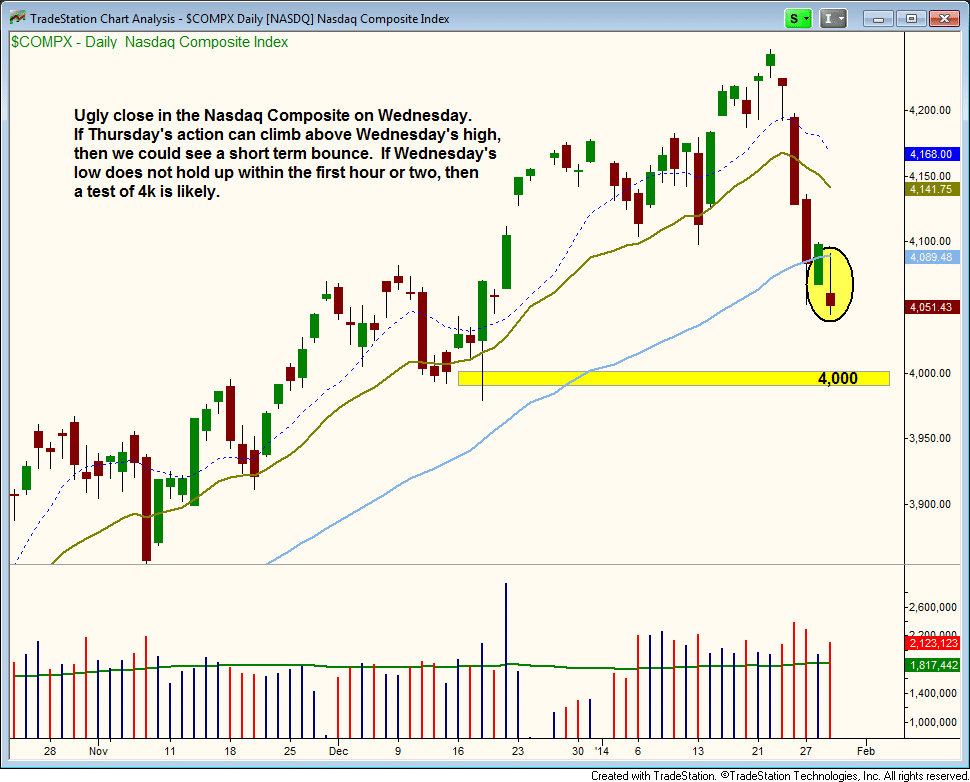 On January 27, I said it was not yet time to sell stocks, but the technical situation has deteriorated quite rapidly since then.
On January 27, I said it was not yet time to sell stocks, but the technical situation has deteriorated quite rapidly since then.
Yesterday (an FOMC day), stocks saw heavy volume selling action that produced another “distribution day” (a decline on increasing volume) in both the S&P 500 and NASDAQ Composite.
In a healthy market, a few days of institutional selling over a 3 to 4-week period is normal and can typically be absorbed by demand.
However, when the running count of distribution days reaches five or more, it nearly always signals a substantial correction is just around the corner.
The 3-Part Test
There are three main components that determine the mode of my broad market timing model, which determines whether I focus on the long or short side of the market, and how aggressively to do so. Right now, only one of those three tests is (barely) holding up.
1.) Volume Pattern Of Broad Market
In the NASDAQ, yesterday was the seventh day of higher volume selling in recent weeks. As such, the volume pattern portion of my broad market timing model is now flashing a clear “sell” signal.
2.) Broad Market Trend
In my January 27 blog post, I also mentioned one positive element of current market conditions was that both the NASDAQ and small-cap Russell 2000 were still holding above key support of their 50-day moving averages. But that is no longer the case.
With all broad-based indexes now below their respective 50-day moving averages, the trend component of the timing model has shifted to a “sell” signal as well (though I would like to give it to the end of the week to see if the NASDAQ can bounce back).
3.) Performance Of Leadership Stocks
The third and final component of our timing model, the performance of leadership stocks, is the only part of the model that is preventing the current “neutral” mode from officially shifting to “sell” mode (click here to see the five modes). Still, even this portion is barely holding on.
NASDAQ 4000 – Coming Soon?
Taking an updated look at the daily chart of the NASDAQ (below), notice the tech-heavy index reversed lower after running into new resistance of its 50-day moving average yesterday (January 29). The index also closed near its intraday low, near the intraday low of January 27 (near-term support).
If the price action follows through to the downside today (January 30), then bearish short-term momentum will likely take the index down to the 4,000 area (support of the December 2013 lows). However, a false move lower in the first hour of trading that subsequently reverses above the previous day’s high could lead to a short-term bounce:

Although my swing trading newsletter is not yet in full “sell” mode, I have been laying low (in “neutral” mode) this week. But as a bonus, a positive earnings report from Facebook ($FB) has currently launched our existing long position to an unrealized gain of approximately 27% since our December 2 buy entry.
The long side of the stock market is all about low volatility and steady/reliable price action. However, current conditions are quite volatile.
Therefore, even if I spot new bullish setups on the long side of the market (such as $AMBA or $AL), the stock market is simply too unstable right now to add new exposure with confidence.
Trade What You See, Not What You Think!
Obviously, there are quite a few scenarios that could play out from here, and that is why we always shy away from predicting market action and worrying about where the major averages will go.
Consistently profitable trading is all about reacting to price action, not predicting it. I can discuss different possibilities and have a plan in place, but I still have no clue what will happen tomorrow.
If my timing model shifts into full “sell” signal, I will then start focusing on short selling stocks and ETFs with the most relative weakness.
Nevertheless, with the market already down sharply in such a short period of time, there are simply no low-risk short entries at the moment.
Chasing on the short side can be just as bad or worse than chasing longs. If you have ever been caught in a short squeeze, you know that the price action can explode higher for several days before taking a break.
With the very real possibility of a significant correction just around the corner, this is a great time to review my preferred strategy for entering new trades on the short side. Upon doing so, you will surely see the importance of maintaining discipline and patience right now.
Want to make sure you are instantly alerted to a new “sell” signal? Subscribe today to The Wagner Daily and you will stay out of trouble, while also knowing when it’s time to step back on the gas again.

Great Deron, thanks for the update. I’ll go review my charts and confirm we are looking our our signals correctly. It is always good to have a professional like yourself lead the pack, and, show confirming signs.
Hey Jim,
No problem. Glad you found the analysis helpful.
I’m certainly not a perfect trader, but I’ve been doing this long enough to know the objective, reliable signals that precede market corrections.
Cheers,
Deron
Simply wanted to say I recognize your blogs and am looking ahead for more to return!
I asked a question and it was never posted? What about the fact the market has rocketed up since this email? Do bad calls get ignored and not explained? Is that how it goes? I’m confused.
Hi Ryan,
Your question you asked was only a few hours ago, and it sometimes takes us a day or two to approve the comments.
Actually, this was not a “bad call” because our market timing system is rule-based and the parameters of the system simply caused the model to shift to “sell” signal.
Furthermore, as our newsletter subscribers already know, WE STILL ARE (as of this morning) on a sell signal because the price action in the S&P and Dow have not confirmed the relative strength in the NASDAQ.
Further, the volume patterns are not confirming either.
Nevertheless, even though our timing model is on a “sell” signal, we stll remain long quite a few positions in our newsletter, several of which are showing rather sizeable unrealized gains because we held them through the correction. A sell signal does NOT mean we panic and sell our best winning trades.
When we enter a sell signal, we do not necessarily sell all our stocks, though we tighten stops to reduce risk. It simply means we avoid new long entries, which we still are until we get confirmation in the S&P and NASDAQ.
Bottom line is that we have continued to make money on the long side of the market, despite the sell signal. We merely have reduced risk on the long side (and have NOT entered any new short positions yet either). Wagner Daily newsletter subscribers know this because we update our open positions and watchlist every day…nothing to hide here.
Based on today’s action, our timing system may actually trigger back into a “buy” signal by tomorrow, but that still would not make it a “bad” call. The timing system just tells us how much money to risk, and on which side of the market.
Hope that clears things up for you. Thanks for your comments.
Thank you for your response. First of all clearly it was my fault, I left this message yesterday but somehow I screwed up and it didn’t take, I wasn’t referring to this post in terms of your timing, I was blaming you for my mistake, my bad. Secondly it might be because I’m frustrated, not at you, but ever since the Fed has created more debt from 2009-2012 than all of US History I can’t make a call to save my life. How can one make calls in an artificial market where there is a puppet master pulling the strings? “bad call” as you clearly pointed out was probably not the right choice of words. Again it goes back to my initial issue with the market, that it’s on puppet strings as it should clearly go down for a variety of reasons. I appreciate the response and as a result I’m going to sign up. AND SEE if we can avoid more “bad calls” than good. LOL. thanks, ryan
Hi Ryan,
Appreciate the follow-up comment. No worries on our end, as we certainly understand how mentally challenging this business can be at times.
I see that you just signed up for The Wagner Daily newsletter, so we will work hard to help turn things around for you.
We pride ourselves on truly giving a personal touch with helping our traders. As such, please try to attend the live “members only” webinars every Monday and Wednesday, as they really help on the education side.
Also, if you don’t have another daytime job and can attend the live mentorship room the first 2 hours every day, that would be great too.
Enjoy and good trading to you.
Deron
kind of missed that one.